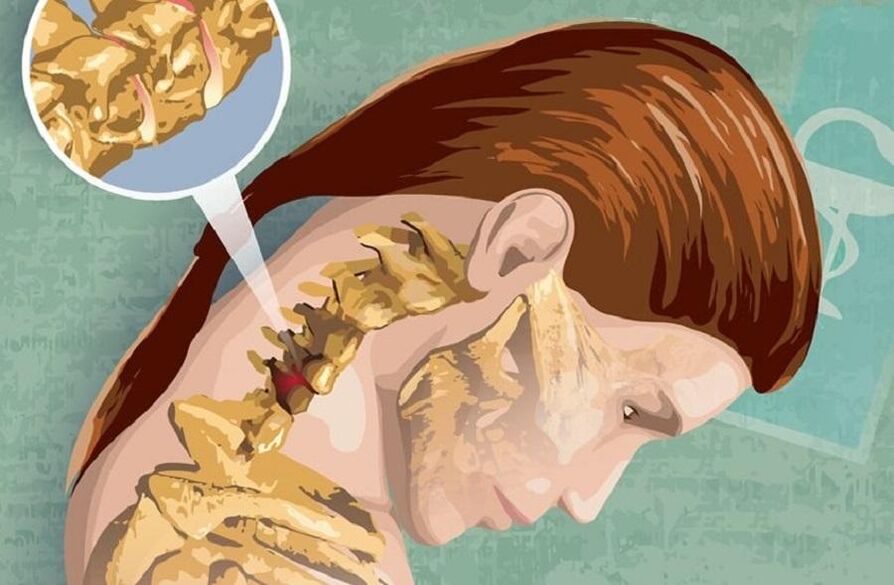In the modern world, the resonance of the disease with cervical osteochondrosis can hardly be overestimated. Osteochondrosis of the cervical region is more common than other vertebral areas. Almost all people over the age of twenty-five suffer from this disease to one degree or another.

Cervical osteochondrosis develops mainly due to a sedentary lifestyle, which is facilitated by a historical transition from physical to mental labor, which is accompanied by, albeit moderately, sedentary work.
Cervical osteochondrosis is a degenerative-dystrophic disease of the cervical spine, which causes damage to the intervertebral discs and is common for osteochondrosis. This part of the spine is very mobile by nature, but at the same time it is sensitive to a poorly developed muscle corset, so any adverse impact on the neck or back primarily affects the cervical region. Because degenerative changes develop most in the mobile vertebral sections, C5 suffers the most in the cervical region. . . These are the nerve endings at the level of C7.
Because the symptoms of cervical osteochondrosis are so controversial, they are not always taken as symptoms of the disease alone, which often leads to the need for help from specialists in other fields of medicine. Let's take a closer look at them.
Symptoms
Because the cervical spine is quite compact compared to other sections, even slight tension in the neck muscles or displacement of the cervical vertebrae can cause the nerve roots to constrict or constrict. it also affects the vessels located in this branch. Well, osteophytes - bone growths, in folk medicine, are called "salt deposition" and occur in the development of the disease with cervical osteochondrosis, resulting only in a significant deterioration in the course of the disease.
The clinical manifestations of cervical osteochondrosis, ie its symptoms, can be divided into reflex symptoms and radicular symptoms of cervical osteochondrosis.
Reflex symptoms of cervical osteochondrosis

Reflex symptoms of cervical osteochondrosis include the so-called "lumbago", which is characterized by the appearance of sharp pains in the neck and is significantly intensified by any movement. With this in mind, patients often assume a kind of forced, most comfortable head position. In addition, it is quite possible that a typical "squeak" will occur during turning or other head movements.
Patients with cervical osteochondrosis often experience headaches, which are oppressive in nature and spread to the eyeballs or the temporal part of the head. In addition, sometimes the sharpness of visual perception can be reduced at the same time, as if "everything is floating in sight. "
Vertebral artery syndrome can also develop when its nerve plexus is irritated, which is often mistakenly diagnosed in the patient as dizziness, a cerebral circulatory disorder. Such a symptom of cervical osteochondrosis can manifest itself with sudden movements of the head and can be complicated by nausea and possible vomiting.
In addition to the above, the reflex symptoms of cervical osteochondrosis include cardiology syndrome, in which there are feelings similar to an angina attack. However, such a manifestation of the symptoms of osteochondrosis is usually combined with a complex of other symptoms of the disease, so it is usually not difficult to make a correct diagnosis.
Radical symptoms of cervical osteochondrosis
Radical symptoms of cervical osteochondrosis, as a rule, appear due to compression of the end of the spinal nerve - the root. In this case, the sensory disorders that affect motor function depend entirely on which nerve root is damaged, namely:
- C1 - decreased sensitivity in the back of the head;
- C2 - pain in the parietal or occipital region of the head;
- C3 - impaired sensitivity and the appearance of pain in the neck, where the spinal cord is damaged by a very possible impairment of speech function due to loss of sensitivity and control of the tongue;
- C4 - the appearance of pain and decreased sensitivity in the humeroscapular dorsal region with a simultaneous decrease in the tone of the neck muscles and possible respiratory disorders of respiratory function, as well as pain in the heart and liver;
- C5 - decreased sensitivity and pain on the outer shoulder surface;
- C6 - pain from the cervical region to the back, the outer surface of the shoulders, forearm and even from the wrist to the thumb;
- C7 - Same pain as in C6, but spreads from the scapula to the back of the shoulder and further from the forearm to the 2nd to 4th fingers, reducing sensitivity in the area of pain;
- C8 - Decreased sensitivity and pain from the neck to the shoulder, and then from the forearm to the little finger.
Treatment

Cervical osteochondrosis is a very complex and very unpleasant disease, the treatment of which requires a sequence, duration and stages. Therapeutic treatment of cervical osteochondrosis is primarily aimed at the complete cessation of pain symptoms of cervical osteochondrosis and the elimination of inflammation in the affected area of the neck.
Patients are treated with classic analgesics such as analgin, ketorol or baralgin in the treatment of cervical osteochondrosis. However, in recent years, non-steroidal anti-inflammatory drugs have also become widely used in the treatment of osteochondrosis of the cervical spine, effectively relieving pain and reducing the activity of inflammation.
Among other things, in the treatment of cervical osteochondrosis, chondroprotectors are used, which slow down the process of destruction of cartilage tissue and, according to many experts, help in the process of their recovery. In addition, patients are prescribed the use of B vitamins, which improve metabolic processes in the patient's body.
However, the use of external gels or ointments for the treatment of cervical osteochondrosis is not effective, but it makes sense, because in the process of rubbing them on the skin, additional massage of the cervical region of the spine is carried out.
In addition, physiotherapy procedures are combined with traditional drug treatment of cervical osteochondrosis, and the use of magnetotherapy, especially through specialized medical devices that have earned a well-deserved reputation among specialists and patients, is particularly effective. In addition to the above, therapeutic massage, physiotherapy exercises and hand therapy are also used. However, surgery may be required, especially in severe cases.
Prevention of cervical osteochondrosis
Cervical osteochondrosis in itself is not difficult to prevent. Recommendation:
- maintain an active and healthy lifestyle,
- exercise or at least morning exercises,
- authorized organization of the workplace,
- to follow the work and rest regime;
- during long-term work in a sitting position - to warm up several times during working hours and to ensure the correct position of the head and posture during work.
It is also important to choose a comfortable pillow and mattress for sleeping. However, for those who already suffer from this disease, the daily use of special orthopedic products for comfortable sleep is strongly recommended.

























